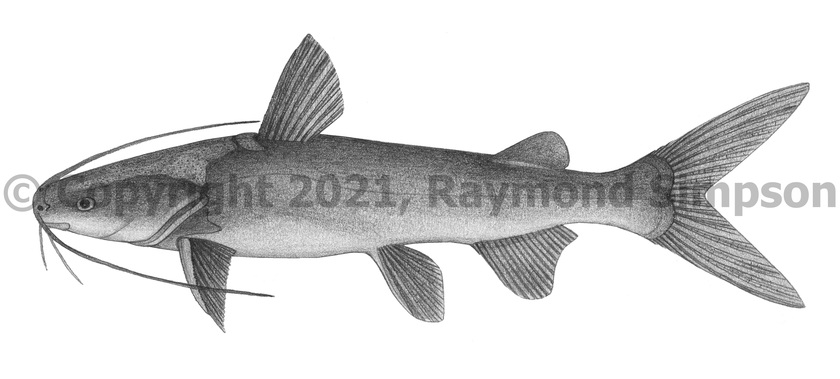
Common Name
Pemecou Sea Catfish
Year Described
Bloch, 1794
Identification
Dorsal Fin: I, 7
Anal Fin: 17-20
Pectoral Fin: 10-11 rays
Pelvic Fin: 6
Caudal Fin: 13 branched (6 upper, 7 lower)
Gill Rakers: 19-26 (second arch)
Sciades is defined by the combination of the following characters described in Marceniuk & van der Steen (2017): medial fleshy groove absent or present, a tiny fenestra between frontal and lateral ethmoid, posterior cranial fontanel closed, epiooccipital projecting into dorsal shield, occipital process short and tapering posteriorly, nuchal shield small/medium sized and crescent-shaped, vomerine tooth patch present, accessory tooth plates long, and adipose fin as long as anal fin.
Body elongate and robust with a strongly arched back. Head slightly flattened. Greatest body depth at dorsal fin. Snout evenly rounded. Nostrils connected by a conspicuous furrow. Anterior nostril fleshy and posterior covered by a flap. Cephalic shield large and very rough; extends well forward to between eyes with a shallow indent in the middle of the head. Supraoccipital process fairly long but wide at the base, with a slightly defined keel and tapering posteriorly. Nuchal plate a thick crescent and rough. Mouth subterminal. Eye relatively large. There are three pairs of barbels (one maxillary and 2 mental) with the maxillary barbel reaching well past the pectoral fin base. A single arched patch of villiform teeth cross maxillary. Vomerine tooth patch present. Accessory patches with moderate posterior extensions in adults and fused to vomerine patch. Dorsal fin high with a strong serrated spine. Pectoral fins about the same size as dorsal fin with strong, weakly serrated spines. Pelvic and anal fins located far back on body. Pelvic fins broad. Adipose fin as long as anal fin. Caudal fin strongly forked. Only rudimentary rakers on rear of gill arches. Body naked.
Color
Dark brown to gray above and on flanks. Belly is abruptly white. Edge of opercle white. Maxillary barbels dark. Fins dark.
Size
Maximum size to 55cm TL but mostly under 40cm TL.
Habitat
Found in fresh, brackish, and marine waters in estuaries, mangrove swamps, and river mouths.
Range
Colombia to northern Brazil (Amazon mouth).
References
Acero, A. 2002. Ariidae (pp 831-852). In: Carpenter. 2002. The living marine resources of the Western Central Atlantic. Vol. 2: Bony fishes part 1 (Acipenseridae-Grammatidae). FAO Species Identification Guides for Fisheries Purposes. American Society of Ichthyologists and Herpetologists Special Publication No. 5.
Marceniuk, A.P. & van der Steen, P. 2017. Family Ariidae. In: van der Sleen, P., & Albert, J.S. (Eds.). 2017. Field guide to the fishes of the Amazon, Orinoco, and Guianas (Vol. 115). Princeton University Press.
Other Notes
Species of Sciades are distinctive in having a deep groove (furrow) running between the posterior nostrils. Sciades couma and S. herzbergii are closely related but differ in gill raker count and the shape of the nuchal plate.